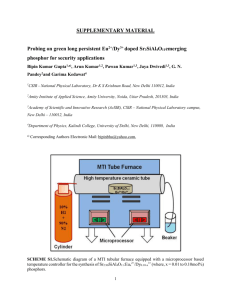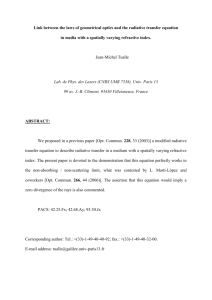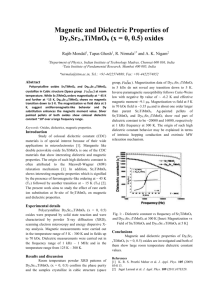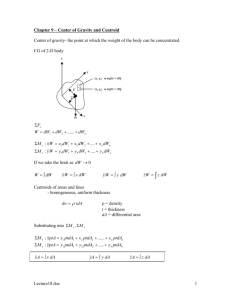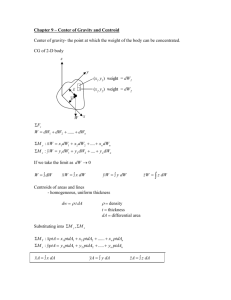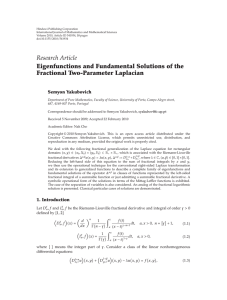ON A SUBCLASS OF n
advertisement
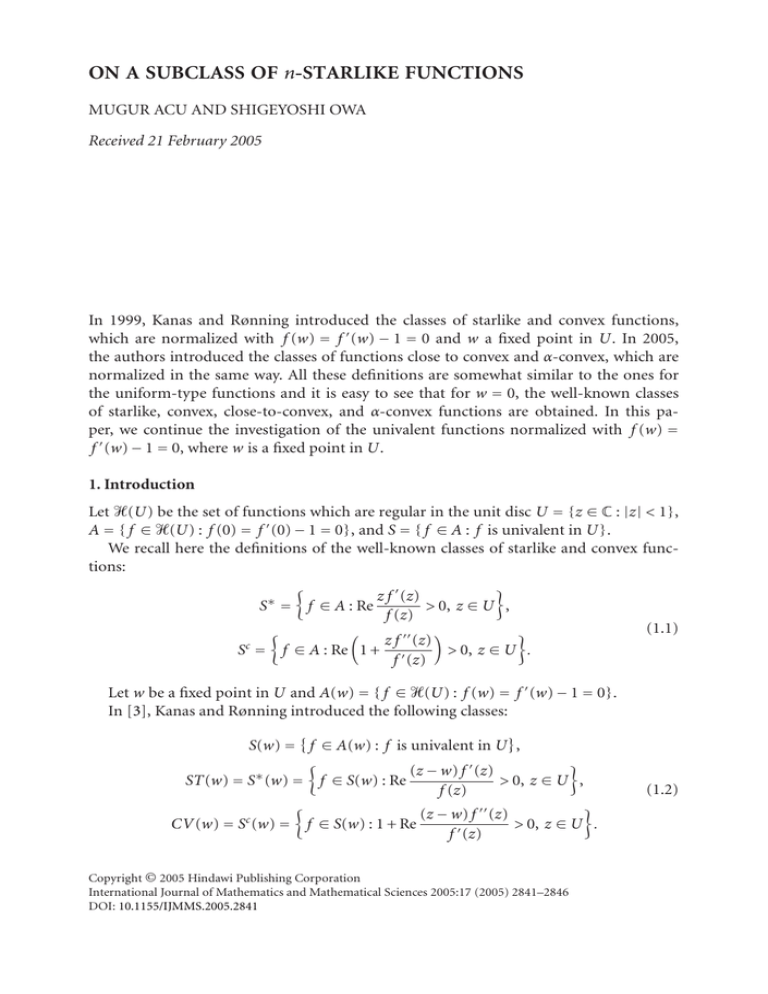
ON A SUBCLASS OF n-STARLIKE FUNCTIONS
MUGUR ACU AND SHIGEYOSHI OWA
Received 21 February 2005
In 1999, Kanas and Rønning introduced the classes of starlike and convex functions,
which are normalized with f (w) = f (w) − 1 = 0 and w a fixed point in U. In 2005,
the authors introduced the classes of functions close to convex and α-convex, which are
normalized in the same way. All these definitions are somewhat similar to the ones for
the uniform-type functions and it is easy to see that for w = 0, the well-known classes
of starlike, convex, close-to-convex, and α-convex functions are obtained. In this paper, we continue the investigation of the univalent functions normalized with f (w) =
f (w) − 1 = 0, where w is a fixed point in U.
1. Introduction
Let Ᏼ(U) be the set of functions which are regular in the unit disc U = {z ∈ C : |z| < 1},
A = { f ∈ Ᏼ(U) : f (0) = f (0) − 1 = 0}, and S = { f ∈ A : f is univalent in U }.
We recall here the definitions of the well-known classes of starlike and convex functions:
S∗ = f ∈ A : Re
z f (z)
> 0, z ∈ U ,
f (z)
(1.1)
z f (z)
> 0, z ∈ U .
S = f ∈ A : Re 1 + f (z)
c
Let w be a fixed point in U and A(w) = { f ∈ Ᏼ(U) : f (w) = f (w) − 1 = 0}.
In [3], Kanas and Rønning introduced the following classes:
S(w) = f ∈ A(w) : f is univalent in U ,
ST(w) = S∗ (w) = f ∈ S(w) : Re
(z − w) f (z)
> 0, z ∈ U ,
f (z)
CV (w) = Sc (w) = f ∈ S(w) : 1 + Re
(z − w) f (z)
> 0, z ∈ U .
f (z)
Copyright © 2005 Hindawi Publishing Corporation
International Journal of Mathematics and Mathematical Sciences 2005:17 (2005) 2841–2846
DOI: 10.1155/IJMMS.2005.2841
(1.2)
2842
On a subclass of n-starlike functions
It is obvious that a natural “Alexander relation” exists between the classes S∗ (w) and
Sc (w):
g ∈ Sc (w)
iff f (z) = (z − w)g (z) ∈ S∗ (w).
Denote with ᏼ(w) the class of all functions p(z) = 1 +
ular in U and satisfy p(w) = 1 and Re p(z) > 0 for z ∈ U.
∞
n=1 Bn · (z − w)
(1.3)
n
that are reg-
2. Preliminary results
If is easy to see that a function f(z) ∈ A(w) has the series of expansions:
f (z) = (z − w) + a2 (z − w)2 + ....
(2.1)
In [8], Wald gives the sharp bounds for the coefficients Bn of the function p ∈ ᏼ(w).
Theorem 2.1. If p(z) ∈ ᏼ(w), p(z) = 1 +
Bn ≤
∞
n=1 Bn · (z − w)
2
,
(1 + d)(1 − d)n
n,
then
where d = |w|, n ≥ 1.
(2.2)
Using the above result, Kanas and Rønning obtain the following theorem in [3].
Theorem 2.2. Let f ∈ S∗ (w) and f (z) = (z − w) + b2 (z − w)2 + .... Then
b2 ≤
2
1 − d2
2 (2 + d)(3 + d)
b4 ≤ · 3 ,
3
1 − d2
b3 ≤ 3 + d ,
2
1 − d2
,
1 (2 + d)(3 + d)(3d + 5)
b5 ≤ ·
,
4
6
1 − d2
(2.3)
where d = |w|.
Remark 2.3. It is clear that the above theorem also provides bounds for the coefficients of
functions in Sc (w), due to the relation between Sc (w) and S∗ (w).
In [1], are also defined the following sets:
D(w) = z ∈ U : Re
w
z(1 + z)
< 1, Re
>0
z
(z − w)(1 − z)
s(w) = f : D(w) −→ C ∩ S(w);
for w = 0, D(0) = U;
s∗ (w) = S∗ (w) ∩ s(w),
(2.4)
where w is a fixed point in U.
M. Acu and S. Owa
2843
The authors consider the integral operator La : A(w) → A(w) defined by
f (z) = La F(z) =
1+a
·
(z − w)a
z
w
F(t) · (t − w)a−1 dt,
a ∈ R, a ≥ 0.
(2.5)
The next theorem is a result of the so called “admissible functions method” introduced
by Mocanu and Miller (see [3, 4, 6]).
Theorem 2.4. Let h be convex in U and Re[βh(z) + γ] > 0, z ∈ U. If p ∈ Ᏼ(U) with p(0) =
h(0) and p satisfied the Briot-Bouquet differential subordination
p(z) +
zp (z)
≺ h(z),
βp(z) + γ
(2.6)
then p(z) ≺ h(z).
3. Main results
Deffinition 3.1. Let w be a fixed point in U, n ∈ N. Dwn denotes the differential operator:
Dwn : A(w) −→ A(w) with ,
Dw0 f (z) = f (z),
Dw1 f (z) = Dw f (z) = (z − w) · f (z),
(3.1)
Dwn f (z) = Dw Dwn−1 f (z) .
Remark 3.2. For f ∈ A(w), f (w) = (z − w) +
Dwn f (z) = (z − w) +
∞
∞
j =2 a j (z − w)
j,
we have
j n · a j · (z − w) j .
(3.2)
j =2
It easy to see that if we take w = 0, we obtain the Sălăgean differential operator (see [7]).
Deffinition 3.3. Let w be a fixed point in U, n ∈ N and f ∈ S(w). f is said to be an
n-w-starlike function if
Re
Dwn+1 f (z)
> 0,
Dwn f (z)
z ∈ U.
(3.3)
The class of all these functions is denoted by S∗n (w).
Remark 3.4. (1) S∗0 (w) = S∗ (w) and S∗n (0) = S∗n , where S∗n is the class of n-starlike functions introduced by Sălăgean in [7].
(2) If f (z) ∈ S∗n (w) and we denote Dwn f (z) = g(z), we obtain g(z) ∈ S∗ (w).
(3) Using the class s(w), we obtain s∗n (w) = S∗n (w) ∩ s(w).
Theorem 3.5. Let w be a fixed point in U and n ∈ N. If f (z) ∈ s∗n+1 (w) then f (z) ∈ s∗n (w).
This means
s∗n+1 (w) ⊂ s∗n (w).
(3.4)
2844
On a subclass of n-starlike functions
Proof. From f (z) ∈ s∗n+1 (w), we have Re(Dwn+2 f (z)/Dwn+1 f (z))>0, z ∈ U. We denote p(z) =
(Dwn+1 f (z)/Dwn f (z)), where p(0) = 1 and p(z) ∈ Ᏼ(U). We obtain
(z − w) Dwn+1 f (z)
Dwn+1 f (z)
Dwn+2 f (z) Dw Dwn+1 f (z)
=
=
= ,
n+1
n
n
Dw f (z)
Dw Dw f (z)
(z − w) Dw f (z)
Dwn f (z)
Dwn+1 f (z) · Dwn f (z) − Dwn+1 f (z) · Dwn f (z)
p (z) =
Dwn f (z)
2
(3.5)
Dn+1 f (z)
Dwn f (z)
Dwn f (z)
= w
−
p(z)
·
.
·
Dwn f (z)
Dwn f (z)
Dwn f (z)
Thus we have
Dn+1 f (z)
(z − w) · Dwn f (z)
(z − w) · p (z) = w
·
Dwn f (z)
Dwn f (z)
− p(z) ·
(z − w) · Dwn f (z)
,
Dwn f (z)
2
Dn+1 f (z)
(z − w) · p (z) = w
· p(z) − p(z) ,
n
Dw f (z)
Dwn+1 f (z)
1
· (z − w) · p (z).
= p(z) +
p(z)
Dwn f (z)
(3.6)
From Re(Dwn+2 f (z)/Dwn+1 f (z)) > 0 we obtain p(z) + (1/ p(z)) · (z − w) · p (z) ≺ ((1 +
z)/(1 − z)) or
p(z) +
zp (z)
1+z
≺
≡ h(z),
1/ 1 − (w/z) · p(z) 1 − z
with h(0) = 1.
(3.7)
By hypothesis, we have Re[1/(1 − (w/z)) · h(z)] > 0, and thus from Theorem 2.4 we ob
tain p(z) ≺ h(z) or Re p(z) > 0. This means f ∈ s∗n (w).
Remark 3.6. From Theorem 3.5, we obtain s∗n (w) ⊂ s∗0 (w) ⊂ S∗ (w), n ∈ N.
Theorem 3.7. If F(z) ∈ s∗n (w) then f (z) = La F(z) ∈ S∗n (w), where La is the integral operator defined by (2.5).
Proof. From (2.5) we obtain
(1 + a) · F(z) = a · f (z) + (z − w) · f (z).
(3.8)
By means of the application of the operator Dwn+1 we obtain
(1 + a) · Dwn+1 F(z) = a · Dwn+1 f (z) + Dwn+1 (z − w) · f (z)
(3.9)
M. Acu and S. Owa
2845
or
(1 + a) · Dwn+1 F(z) = a · Dwn+1 f (z) + Dwn+2 f (z).
(3.10)
Similarly, by means of the application of the operator Dwn , we obtain
(1 + a) · Dwn F(z) = a · Dwn f (z) + Dwn+1 f (z).
(3.11)
Thus
Dwn+2 f (z)/Dwn+1 f (z) · Dwn+1 f (z)/Dwn f (z) + a · Dwn+1 f (z)/Dwn f (z)
Dwn+1 F(z)
.
=
n
Dw F(z)
Dwn+1 f (z)/Dwn f (z) + a
(3.12)
Using the notation Dwn+1 f (z)/Dwn f (z) = p(z), with p(0) = 1, we have
(z − w) · p (z) Dwn+2 f (z)
= n+1
− p(z)
p(z)
Dw f (z)
(3.13)
Dwn+2 f (z)
(z − w) · p (z)
= p(z) +
.
n+1
Dw f (z)
p(z)
(3.14)
or
Thus
Dwn+1 F(z) p(z) p(z) + (z − w)p (z)/ p(z) + a
=
Dwn F(z)
p(z) + a
zp (z)
.
= p(z) + 1/ 1 − (w/z) p(z) + a/ 1 − (w/z)
(3.15)
From F(z) ∈ s∗n (w) we obtain (Dwn+1 F(z)/Dwn F(z)) ≺ ((1 + z)/(1 − z)) ≡ h(z) or
zp (z)
≺ h(z).
p(z) + 1/ 1 − (w/z) p(z) + a/ 1 − (w/z)
(3.16)
By hypothesis, we have Re[(1/(1 − (w/z))) · h(z)+(a/(1 − (w/z)))] > 0 and from Theorem
2.4 we obtain p(z) ≺ h(z) or Re{Dwn+1 f (z)/Dwn f (z)} > 0, z ∈ U. This means f (z) =
La F(z) ∈ S∗n (w).
Remark 3.8. If we consider w = 0 in Theorem 3.7 we obtain that the integral operator
defined by (2.5) preserves the class of n-starlike functions, and if we consider w = 0 and
n = 0 in the above theorem we obtain that the integral operator defined by (2.5) preserves
the well-known class of starlike functions.
2846
On a subclass of n-starlike functions
Theorem 3.9. Let w be a fixed point in U and f ∈ S∗n (w) with f (z) = (z − w) +
(z − w) j . Then
a2 ≤
1
,
2 n −1 · 1 − d 2
a3 ≤
3+d
2 ,
3n · 1 − d 2
a4 ≤
(2 + d)(3 + d)
3 ,
22n−1 · 3 · 1 − d2
∞
j =2 a j
·
(3.17)
(2 + d)(3 + d)(3d + 5)
a5 ≤
4 ,
5n · 6 · 1 − d 2
where d = |w|.
Proof. From Remark 3.4 for f ∈ S∗n (w) we obtain
Dwn f (z) = g(z) ∈ S∗ (w).
(3.18)
j
If we consider g(z) = (z − w) + ∞
j =2 b j · (z − w) , using Remark 3.2, from (3.18) we
n
obtain j · a j = b j , j = 2,3,....
Thus we have a j = 1/ j n · b j , j = 2,3,..., and from the estimates (2.3) we get the result.
References
[1]
[2]
[3]
[4]
[5]
[6]
[7]
[8]
M. Acu and S. Owa, On some subclasses of univalent functions, JIPAM. J. Inequal. Pure Appl.
Math. 6 (2005), no. 3, article 70, 1–6.
A. W. Goodman, On uniformly convex functions, Ann. Polon. Math. 56 (1991), no. 1, 87–92.
S. Kanas and F. Rønning, Uniformly starlike and convex functions and other related classes of
univalent functions, Ann. Univ. Mariae Curie-Skłodowska Sect. A 53 (1999), 95–105.
S. S. Miller and P. T. Mocanu, Differential subordinations and univalent functions, Michigan
Math. J. 28 (1981), no. 2, 157–172.
, On some classes of first-order differential subordinations, Michigan Math. J. 32 (1985),
no. 2, 185–195.
, Univalent solutions of Briot-Bouquet differential equations, J. Differential Equations 56
(1985), no. 3, 297–309.
G. Ş. Sălăgean, Subclasses of univalent functions, Complex Analysis—Fifth Romanian-Finnish
Seminar, Part 1 (Bucharest, 1981), Lecture Notes in Math., vol. 1013, Springer, Berlin, 1983,
pp. 362–372.
J. K. Wald, On starlike functions, Ph.D. thesis, University of Delaware, Delaware, 1978.
Mugur Acu: Department of Mathematics, “Lucian Blaga” University of Sibiu, 5–7 Ion Rat.iu Street,
550012 Sibiu, Romania
E-mail address: acu mugur@yahoo.com
Shigeyoshi Owa: Department of Mathematics, School of Science and Engineering, Kinki University, Higashiosaka, Osaka 577-8502, Japan
E-mail address: owa@math.kindai.ac.jp

